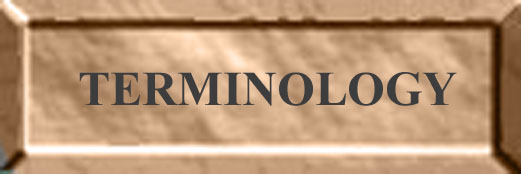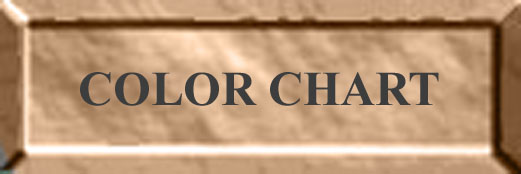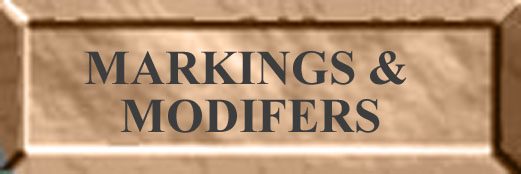 |
 |
 |
|
 |
 |
 |
 |
Q1: Can two red parents ever produce a black pup?
A1: Short of a mutation of b to B, which is very rare, no. Red is recessive to black, so in order for each parent to be a red he/she must have only red genes to give. Possible other explanations for a black pup out of two apparently red parents:
1. One or both parents is actually a black nosed sable, not a true red. Check the parents' nose leather color and the check the hairs for black tipping.
2. One parent is a black nosed yellow, not a red. The hairs are the same color all the way down to the hide, but that black nose is a dead giveaway of the presence of a gene for black.
3. Better check the hole under that fence.
Q2: What do you get when you cross a red merle to a blue merle?
A2: It depends on whether the blue merle carries a red gene recessively. In either case you'd expect a merle ratio of 25% solid, 50% normal merles, 25% homozygous merles. The blue parent must be a red carrier in order for the litter to contain red solids and red merles.
Q3: How can a black bi puppy be born from two black tricolor parents?
A3: The parents could be (ata B- DD kk mm sisi). In this case a puppy could be (ata) at the A locus (tricolor) or he could be (aa) at the A locus (recessive black bi).
Q4: What is running copper?
A4: It's the tan point pattern bleeding into the body color rather than being crisply confined as in a Dobe. Modifying genes cause this, though the exact inheritance is not known.
Q5: What is a sable?
A5: Sables have light colored hair shafts with black or liver tipping and/or black or liver hairs interspersed among the lighter reddish guard hairs. A black nosed sable will have black tipping, while a liver nosed sable will have liver tipping. They differ from yellows in that yellows lack the ability to make liver or black pigment on hairs.
Q6: What is a sable merle?
A6: It's a dog that is both a sable and a merle. In collies, the merling becomes very faint shortly after birth and can become indistinguishable in the adult. In Aussies, we can usually see both the tipping and the merling in the adults as well. Having the blue or black restricted to the tip of the hair somewhat obscures and muddies the merle pattern.
Q7: My blue merle Aussie has a muddy look. Is he a sable?
A7: If his hairs are tipped with black or blue, yes. But he could simply have a brown or buff undercoat that is showing through normal guard hairs that makes him look muddy.
Q8: My blue merle Aussie has a reddish cast. Does this mean he's red factored?
A8: No. Rough collie breeders have to contend with this in their blue merles also, and the red gene is not known to exist in rough collies. It's due to modifiers which must be eliminated by selective breeding to dogs which lack them.
Q9: What is a tweed merle?
A9: A tweed merle is a merled Aussie that has a dominant modifying gene affecting the merling. Instead of the simple blue and black of a regular merle, the dog may have 4 or 5 intermediate shades, each clearly distinct and not running together. These patches occur in a fairly regular pattern all over the body. Reds are affected in the same way as blues, with multiple shades of red. According to Phil Sponenberg, DVM, PhD, it is uncertain at this time whether tweed and harlequin are independent and distinct from each other or whether they are variations of the same gene. Test breedings would be required to determine conclusively whether harlequin and tweed were in fact the same gene.
Q10: What is a harlequin?
A10: A harlequin merle has a dominant modifier that breaks the normal blue and black of a blue merle into intermediate shades. In some cases the patches may be diluted to lacy white areas, similar to the white one would see on a harlequin Dane. Dr. Sponenberg is not certain whether the harlequin modifier in Aussies is the same gene as that studied in the tweed merle dogs.
Q11: What is a yellow Aussie?
A11: A yellow Aussie is a genetically red or black dog whose pigment has been restricted in its development. The nose leather identifies the dog as a red or black, but the hair color can vary from Yellow Labrador light to an Irish setter deep red. A liver nosed reddish yellow can very easily be mistaken for a normal red. If the yellow Aussie is also a merle, the merling won't usually be seen in the coat since merling isn't expressed in the yellow areas. The eyes of a merled yellow may be blue or marbled with blue.
Q12: Does pattern white occur only in merles?
A12: No. The spotting genes on the S locus are inherited independently of merle and are just as likely in solids.
Q13: Is excessive white OK if the dog isn't a merle?
A13: Excessive white in a dog of any color can be a warning sign of potential hearing problems. If there is no pigment in the inner ear the dog will be deaf; white ears are more likely to lack inner ear pigment. In any case, white outside the areas prescribed in the standard disqualify the dog from the conformation ring.
Q14: Can two self colors or dogs with very little white produce a pattern white?
A14: Yes. If they are carriers of the pattern white gene (Ssp), or (sisp) they can. See the picture of "Cotton" on the White Aussies page.
Q15: Two black tris produced a merle pup. How is this possible?
A15: There are a couple of possibilities:
1. One of the "black tris" was really a cryptic merle (rare but it happens).
2. Check that fence again for a hole.
Q16: What is a cryptic (phantom) merle?
A16: A cryptic merle is a dog that is genetically a merle but which is non merle in appearance. The amount of merling is so reduced that it is either inconspicuous, hidden by a white marking, or was only on the portion of the tail removed by docking. A dog that has very reduced merling that is nevertheless visible, such as a blue ear, isn't a cryptic merle. It's a very minimal merle. True cryptic merles are rare. Texas A&M University has devised a genetic test to show whether a dog is mm, Mm, or MM.
Q17: How are dilute spots inherited?
A17: The exact mode of inheritance is not known, but dogs who have them tend to produce them. The presence of a dilute spot or two does not indicate that the dog is a tweed.
Q18: Can a solid colored Aussie have blue eyes?
A18: Yes. There is a recessive gene in some strains of Aussie that produces blue eyes independently of merling. It can produce a dog with two blue eyes, one blue and one pigmented, or irises that are split. Generally these eyes are split geometrically, not marbled. Of course, a blue eyed merle puppy in such a litter may also be expressing this recessive trait and may not have blue eyes simply as part of the action of the merle gene like most blue eyed merles.
Q20: How similar are identical twins in terms of white and merle patterns?
A20: A litter was born in Feb 2000 that contained a pair of identical twin merle pups. They shared the same placenta and fetal sac. They have similar amounts of white and similar merle patterns. They both have split faces. The markings aren't perfect exact duplicates of each other, but they are very close. This is consistent with observations of amount and placement of white markings in identical twin Holstein calves.
Q21: Is it OK to mate two merles together if they are not the same color, if one is a blue merle and one is a red merle?
A21: The merle gene acts independently of body color. So if both parents are a different color, or even a different breed, if both are merles there is the danger of producing homozygous merle pups.
© 1999-2009 Lisa McDonald Comments